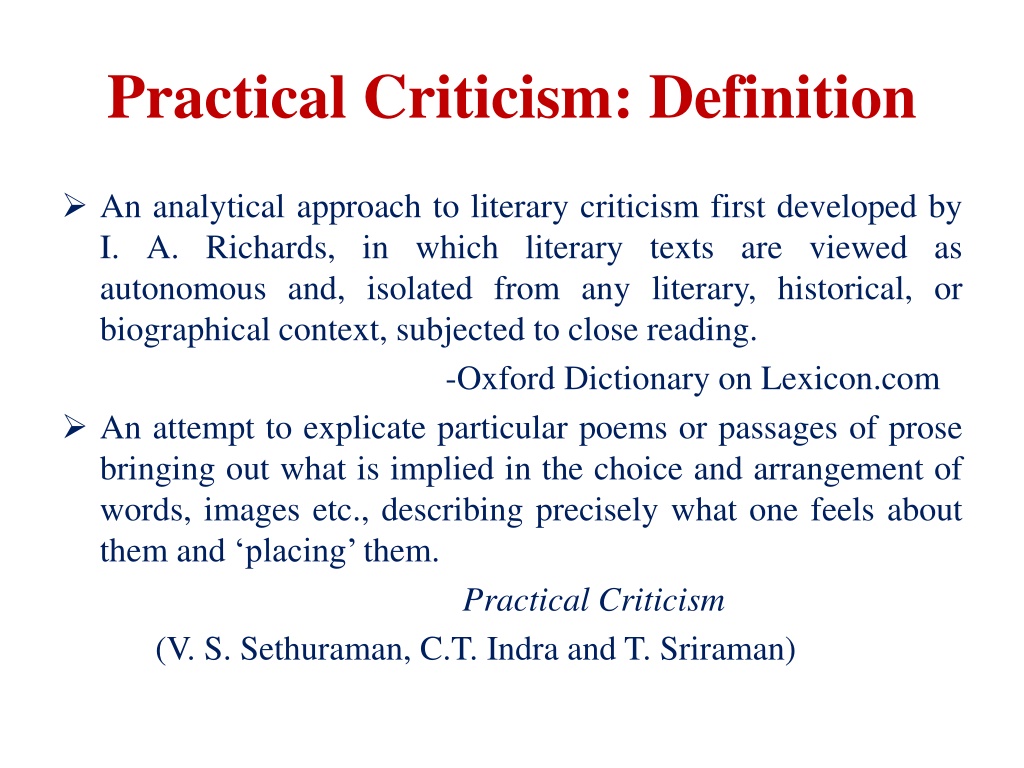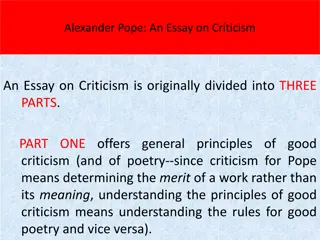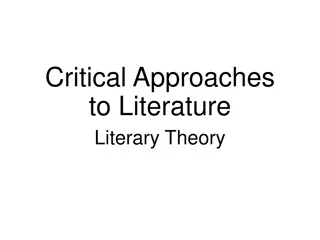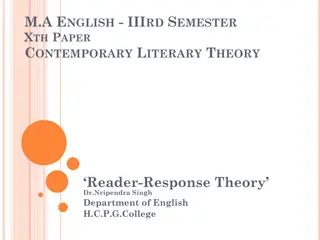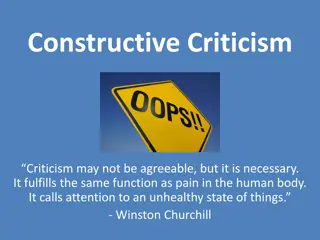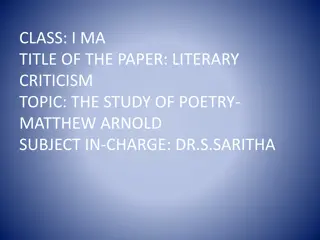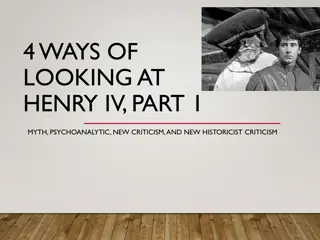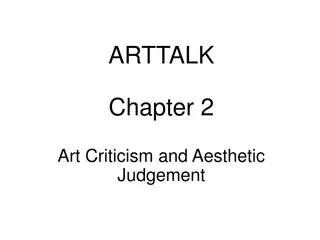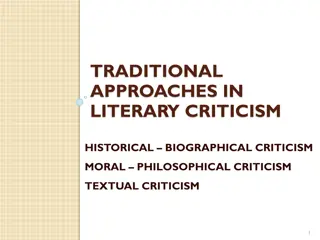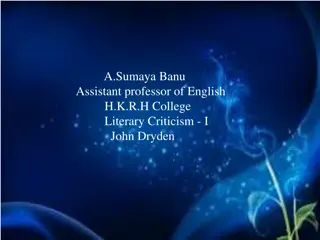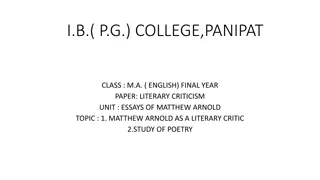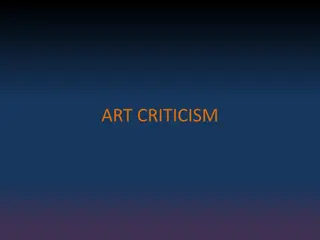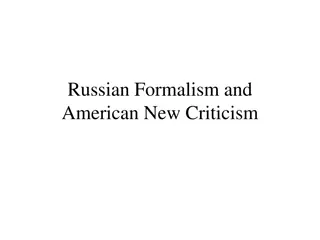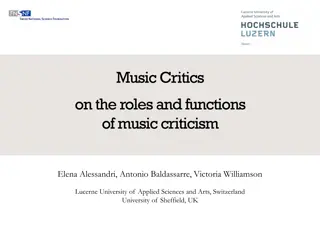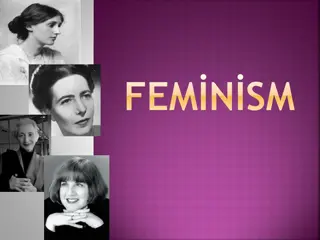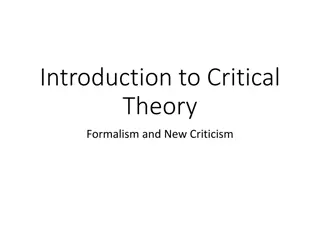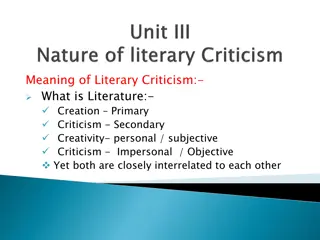Understanding Practical Criticism in Literary Analysis
Analysis of Practical Criticism, an approach developed by I.A. Richards, involves close examination of literary texts without historical or biographical context. It aims to encourage students to respond to poetry and literature by focusing on form and meaning, identifying sources of pleasure. The process includes analyzing subject/theme, content, structure, tone, imagery, and more, culminating in a critical appreciation with three key parts: What, How, Personal Impression/Comments/Summing up.
Download Presentation

Please find below an Image/Link to download the presentation.
The content on the website is provided AS IS for your information and personal use only. It may not be sold, licensed, or shared on other websites without obtaining consent from the author. Download presentation by click this link. If you encounter any issues during the download, it is possible that the publisher has removed the file from their server.
E N D
Presentation Transcript
Practical Criticism: Definition An analytical approach to literary criticism first developed by I. A. Richards, in which literary texts are viewed as autonomous and, isolated from any literary, historical, or biographical context, subjected to close reading. -Oxford Dictionary on Lexicon.com An attempt to explicate particular poems or passages of prose bringing out what is implied in the choice and arrangement of words, images etc., describing precisely what one feels about them and placing them. Practical Criticism (V. S. Sethuraman, C.T. Indra and T. Sriraman)
Origin 1920s- academic procedure initiated by I. A. Richards Series of experiments wherein poems given to students without any historical, biographical context or authorship, date or circumstances of composition Focus on words on the page Close analysis of anonymous poems to achieve an organized response Culmination of the experiments- Practical Criticism (1929) Nature: Ancillary skill Part of examination in literature to test students knowledge of verse forms, responsiveness to poetry, ability to describe its effect No necessary connection with any theoretical approach
Practical Criticism: Aim Encourage students to respond to poetry/ literature Encourage reading, concentrate on form and meaning A lively experience Helps to identify the sources yielding pleasure in a given text Appreciation of an Unseen Poem Questions below the poem should be used only as hints or help while appreciating the poem. Appreciation should be in the form of continuous prose, in the form of paragraphs.
Procedure Analysis of the given poem or prose passage with respect to Subject/ theme Content/ paraphrase Structure Tone Imagery Verbal felicity Metre Figures of Speech
Plan of a Critical Appreciation Three Parts: 1. What 2. How 3. Personal Impression/ Comments/ Summing up
First Part: What Answers to questions like, What is------? the theme of the poem general meaning intention of the poet mood of the poem- light, serious type of the poem- descriptive, narrative, expository special lyrical type if any-sonnet, ballad, ode, elegy etc. the period or literary age to which the poem belongs classification like British, American, African, Indian literature etc. if possible
Second Part: How Discusses the use of various devices by the poet i.e. how the poet has conveyed the what in the poem Devices are of three types: 1. Structural devices- Contrast, Illustration, Repetition 2. Sense devices- Simile, Metaphor and all other Figures of Speech (personification, synechdoche, metonymy, antithesis, oxymoron, apostrophe, litotes, paradox, epigram, irony, circumlocution etc.) 3. Sound devices- rhythm, rhyme, alliteration, assonance, consonance, onomatopoeia etc.
Second Part contd. While writing about these devices a small paragraph for each type of devices is sufficient. Regarding figures of speech and sound devices it is not just enough to locate their use; they should be explained, their significance brought out. Use of inversion or foregrounding if any may also be explained
Sound Devices Rhyme Rhythm (metres) Alliteration Consonance Assonance Repetition/ Refrain Onomatopoeia
Rhyme Perfect Rhymes/ Full Rhymes Rime Riche- same spelling/ words, but different meanings inthe two cases Masculine Rhyme-only final stressed syllable rhymes e.g. bad and mad Feminine Rhyme-final two syllables rhyme of which final syllable is unstressed rhyme e.g. pester and fester Triple Rhyme- three syllables rhyme, but is quite unusual e.g. revision and division Para rhyme/Half rhyme- opening and closing consonants of the rhyming words are same but the middle vowel is different e.g. hall and hell
Rhythm/ Metres/ Prosody Prosody is the study of the metrical pattern of a poem to understand the poetic effects. Scansion is division of words into syllables and determining whether they are stressed or unstressed and thereby deciding the metre used. Syllable- the smallest unit of metrics- any word or part of a word that contains a single voiced vowel or a diphthong with or without any marginal element (consonant). Thus one voiced vowel= one syllable. Monosyllabic word go, taught, sea Disyllabic words- tonight, water, Bruno Trisyllabic / polysyllabic words-property, emphasis
Determining Metre 1ststep-find the average number of syllables in a line e.g. Tell /me/ not/ in/ mourn/ful/ num/bers About 60-80% words in English poetry are monosyllabic 2ndstep divide the syllables into stressed and unstressed ones A syllable that is emphasized/ pronounced more forcefully/ carries more weight is stressed and is denoted by a / whereas an unstressed syllable is denoted by a x Usually syllables take the stress as per the dictionary or as in regular speech but poets sometimes vary the stress in case of monosyllabic words. / x x / wa/ter a /lone
Metres Contd. 3rdstep: Once the stresses are marked the line can be divided into smaller units with equal number of syllables called feet (singular = foot). A foot consists of two or more stressed or unstressed syllables. Basic Metres in English: 1. Iambic foot (x /): one unstressed followed by a stressed 2. Trochaic foot (/ x): one stressed followed by an unstressed 3. Anapaestic foot (xx/) : two unstressed followed by a stressed 4. Dactyllic foot (/xx): one stressed followed by two unstressed
Metres Contd. Supplementary Metres: Spondee (/ /): two stressed syllables Pyrrhic (x x): Two unstressed syllables Amphibrach (x / x): one stressed syllable between two unstressed syllables Based on the number of times a foot is repeated in a line the base metre of the line is determined. e.g. iambic dimetre, iambic trimetre, tetrameter, pentameter etc. Iambic pentameter is the most common metre in English poetry Effect of Metre: Affects the mood of the poem
Third Part This part sums up whatever has gone before. Your impressions about the poem or its effect on you be stated Any comments on the poem in short
Conclusion A humble attempt to allay the fear of students regarding appreciation of a poem Based on experience of teaching poetry Result of attempts at understanding poetry
